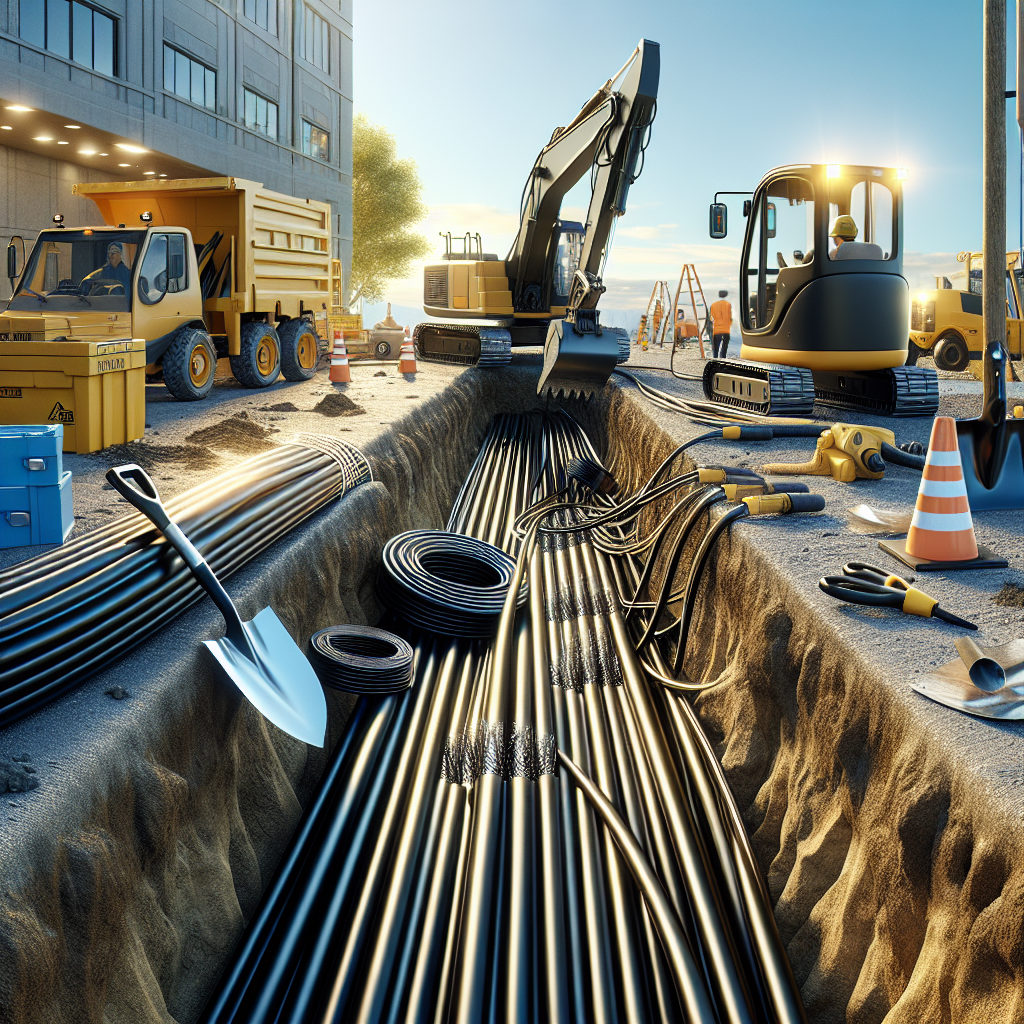In today’s rapidly advancing technological landscape, the need for high-speed internet and reliable data transmission is greater than ever. One of the most efficient ways to meet this demand is by installing fiber optic cables underground. These cables offer unparalleled data transfer speeds and are less susceptible to environmental damage compared to traditional copper cables. However, the process of running fiber optic cables underground requires careful planning, the right tools, and a solid understanding of installation techniques.
Whether you are a business looking to enhance your network infrastructure or a homeowner aiming to improve your internet connectivity, understanding the key steps involved in this process is crucial. This guide will walk you through the essential aspects of how to run fiber optic cable underground, covering everything from the necessary tools and materials to trenching and safety precautions. By following these guidelines, you can ensure a smooth and efficient installation that meets your connectivity needs.
Visit our website to learn more and get started today! Click here.
Necessary Tools and Materials for Installation
Before embarking on the installation of fiber optic cable underground, it is essential to gather all the necessary tools and materials. Having the right equipment not only streamlines the process but also ensures that the installation is done safely and efficiently.
Here is a list of essential tools and materials you will need:
- Fiber Optic Cable: The main component of the installation, choose a cable that meets your data transmission needs and environmental conditions.
- Conduit: A protective casing for the fiber optic cable, typically made of PVC or metal, which safeguards the cable from physical damage and environmental factors.
- Trenching Tools: Shovels, trenchers, or mini excavators to dig the trench where the cable will be laid. The choice of tool depends on the length and depth of the trench required.
- Pulling Tape: Used to pull the fiber optic cable through the conduit, ensuring it is laid out smoothly without kinks or bends.
- Splice Kits: Essential for connecting lengths of fiber optic cable, ensuring a seamless connection that maintains data integrity.
- Safety Gear: Includes gloves, safety glasses, and appropriate footwear to protect yourself during the installation process.
- Measuring Tape: For accurately measuring the length of the trench and the cable.
- Marking Paint or Flags: To indicate where the trench will be dug, helping to avoid any existing underground utilities.
By assembling these tools and materials beforehand, you can approach the installation with confidence, knowing you have everything you need to complete the job efficiently and safely. Proper preparation is key to a successful underground fiber optic cable installation.
Preparing the Site for Trenching
Once you have gathered all the necessary tools and materials, the next step is to prepare the site for trenching. Proper site preparation is crucial to ensure a smooth and efficient installation process.
Here are the steps to follow:
- Site Survey: Conduct a thorough survey of the site to identify the best path for the trench. Consider factors such as existing underground utilities, natural obstacles, and the shortest distance between connection points.
- Obtain Permits: Check with local authorities to determine if you need any permits for trenching and installing fiber optic cables. Ensure all necessary permissions are in place before starting the work.
- Mark the Trench Path: Use marking paint or flags to clearly indicate the path of the trench. This helps avoid any confusion during the digging process and ensures the trench follows the planned route.
- Identify Underground Utilities: Contact utility companies to locate and mark any existing underground utilities such as water, gas, or electrical lines. This step is vital to prevent accidental damage during trenching.
- Clear the Area: Remove any debris, vegetation, or obstacles from the trench path. This makes the trenching process easier and prevents damage to the fiber optic cable.
- Set Up Safety Measures: Ensure the work area is safe by setting up barriers, warning signs, and safety cones. This protects both the workers and the public from potential hazards.
By carefully preparing the site for trenching, you can avoid common pitfalls and ensure a smooth installation process. Taking the time to plan and organize the site will save you time and effort in the long run, leading to a successful underground fiber optic cable installation.
Steps to Trench and Lay Fiber Optic Cable
With the site prepared, it’s time to move on to the actual trenching and laying of the fiber optic cable. This process involves several critical steps to ensure that the cable is installed correctly and functions efficiently.
Follow these steps to trench and lay the fiber optic cable:
- Dig the Trench: Begin by digging the trench along the marked path. The trench should be deep enough to protect the cable from surface activities and environmental factors. Typically, a depth of 24-36 inches is recommended.
- Lay Conduit: Place a conduit or duct in the trench to house the fiber optic cable. This conduit provides extra protection and makes future cable maintenance easier. Ensure the conduit is laid smoothly without sharp bends or kinks.
- Pull the Cable: Carefully pull the fiber optic cable through the conduit. This step requires precision to avoid damaging the cable. Use cable lubricant if necessary to ease the pulling process and prevent friction damage.
- Ensure Proper Bend Radius: Observe the minimum bend radius specified by the cable manufacturer to prevent any damage. Sharp bends can impair the cable’s performance and lead to signal loss.
- Secure the Cable: Once the cable is in place, secure it at regular intervals using cable ties or clips. This prevents the cable from shifting and ensures it remains in place.
- Backfill the Trench: After the cable is laid, backfill the trench with the excavated soil. Compact the soil gently but firmly to avoid damaging the cable while ensuring the trench is properly filled.
- Test the Installation: Once the trench is backfilled, test the fiber optic cable to ensure it is functioning correctly. Perform signal tests to check for any issues before finalizing the installation.
By following these steps meticulously, you can ensure that your fiber optic cable is installed efficiently and effectively. Proper trenching and laying techniques are essential to maintain the integrity of the cable and ensure optimal performance.
Connecting and Testing Fiber Optic Cable
After laying the fiber optic cable, the next crucial phase is connecting and testing the cable to ensure it operates as intended. This step involves meticulous work to guarantee that the connections are secure and the signal transmission is optimal.
Here’s how to connect and test fiber optic cable:
- Strip the Cable: Use a fiber optic stripping tool to carefully remove the outer jacket and buffer coating from the ends of the cables. This exposes the optical fibers without damaging them.
- Clean the Fibers: Clean the exposed fibers using a lint-free wipe and isopropyl alcohol. Any dirt or oil can cause signal loss or interference, so it’s critical to ensure the fibers are spotless.
- Splice the Fibers: Depending on your installation needs, you can either fusion splice or mechanical splice the fibers. Fusion splicing uses heat to join the fibers permanently, while mechanical splicing uses alignment fixtures and gel to hold the fibers together. Fusion splicing is typically preferred for its lower signal loss and higher reliability.
- Protect the Splice: Once spliced, protect the joint using a splice protector sleeve. This sleeve shields the delicate fiber from environmental factors and physical stress.
- Connect to Equipment: Attach the fiber optic connectors to the spliced ends. Ensure that the connectors match the equipment specifications (e.g., LC, SC, ST connectors) and are securely attached.
- Perform Optical Time Domain Reflectometer (OTDR) Testing: Use an OTDR to test the integrity of the fiber optic cable. The OTDR sends light pulses down the cable and measures the return signal, helping to identify any faults or breaks along the length of the cable.
- Conduct End-to-End Testing: Perform end-to-end testing to verify that the entire fiber optic link is functioning correctly. This involves checking the signal strength at both ends of the cable and ensuring there is minimal signal loss.
By carefully connecting and testing the fiber optic cable, you can ensure a reliable and robust network infrastructure. Proper testing is essential to detect and rectify any issues that could compromise the performance of your fiber optic system.
Safety Precautions and Best Practices
Ensuring safety during the installation of fiber optic cable is paramount. Adhering to safety precautions and best practices not only protects the installers but also guarantees the longevity and performance of the installation. Below are essential safety measures and best practices to follow:
- Wear Protective Gear: Always wear appropriate personal protective equipment (PPE) such as safety glasses, gloves, and long sleeves to protect against fiber shards and other hazards.
- Avoid Looking Directly at Fiber Ends: Fiber optic cables can carry laser light that is invisible but harmful to the eyes. Never look directly into the ends of the cables or connectors.
- Handle Fibers with Care: Fiber optic strands are extremely delicate. Avoid bending the fibers beyond their specified bend radius to prevent breakage and signal loss.
- Proper Disposal of Fiber Scraps: Collect all fiber scraps and dispose of them in a designated container to prevent injury and contamination. Fiber shards can easily become airborne and pose a risk.
- Maintain Clean Work Environment: Ensure that the work area is clean and organized. Dust and debris can interfere with fiber connections and splicing.
- Follow Manufacturer Guidelines: Adhere to the installation and safety guidelines provided by the cable and equipment manufacturers. These guidelines are tailored to ensure optimal performance and safety.
- Use Proper Tools: Utilize tools specifically designed for fiber optic installation, such as fiber strippers, cleavers, and splicing machines. Using the correct tools reduces the risk of damage and ensures precision.
- Monitor Environmental Conditions: Install fiber optic cables in environments that are within the recommended temperature and humidity ranges. Extreme conditions can affect the cable’s performance and durability.
By following these safety precautions and best practices, you can ensure a safe and efficient installation process. Taking these measures seriously helps in preventing injuries and maintaining the integrity of the fiber optic system.
Visit our website to learn more and get started today! Click here.





